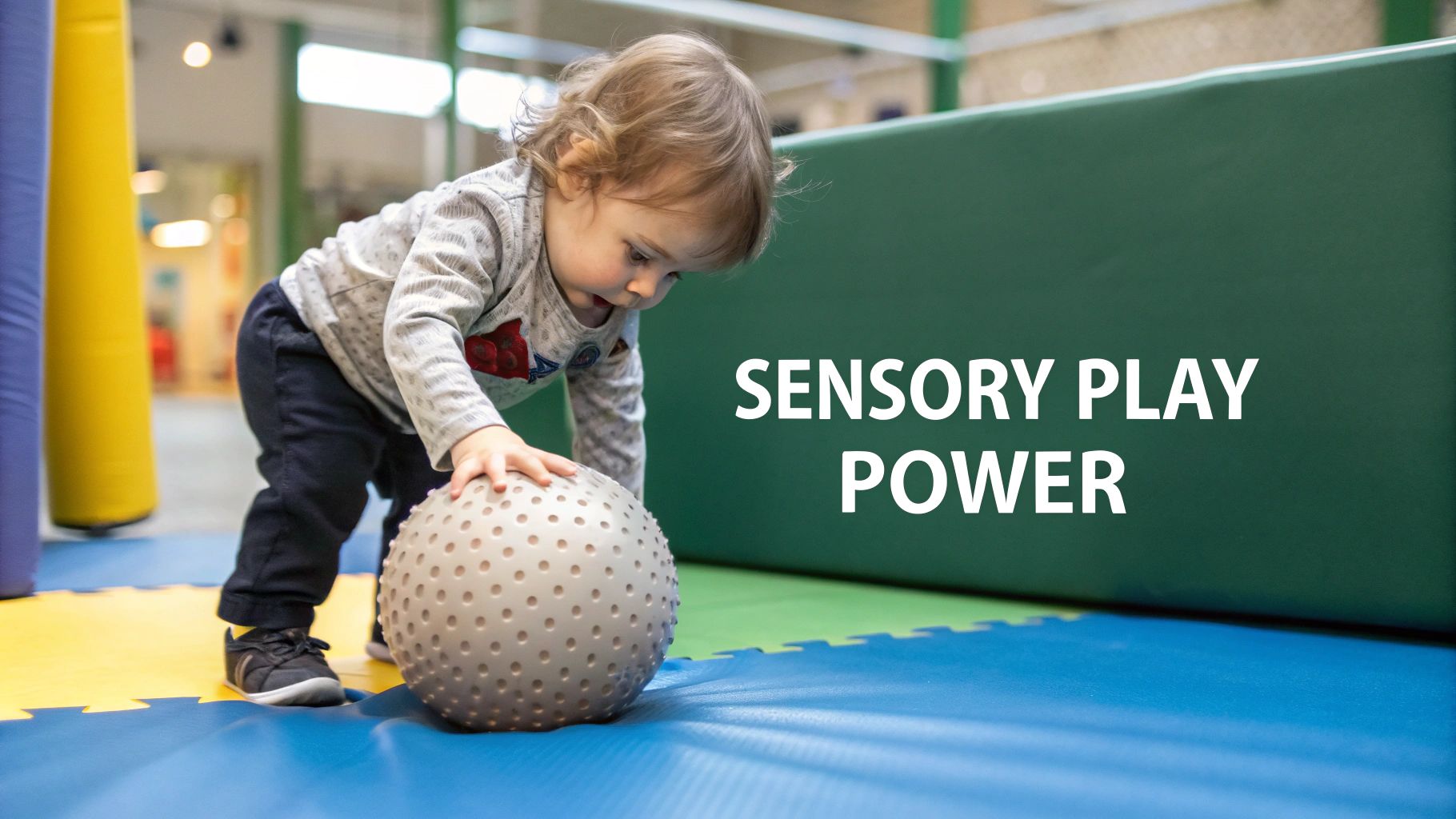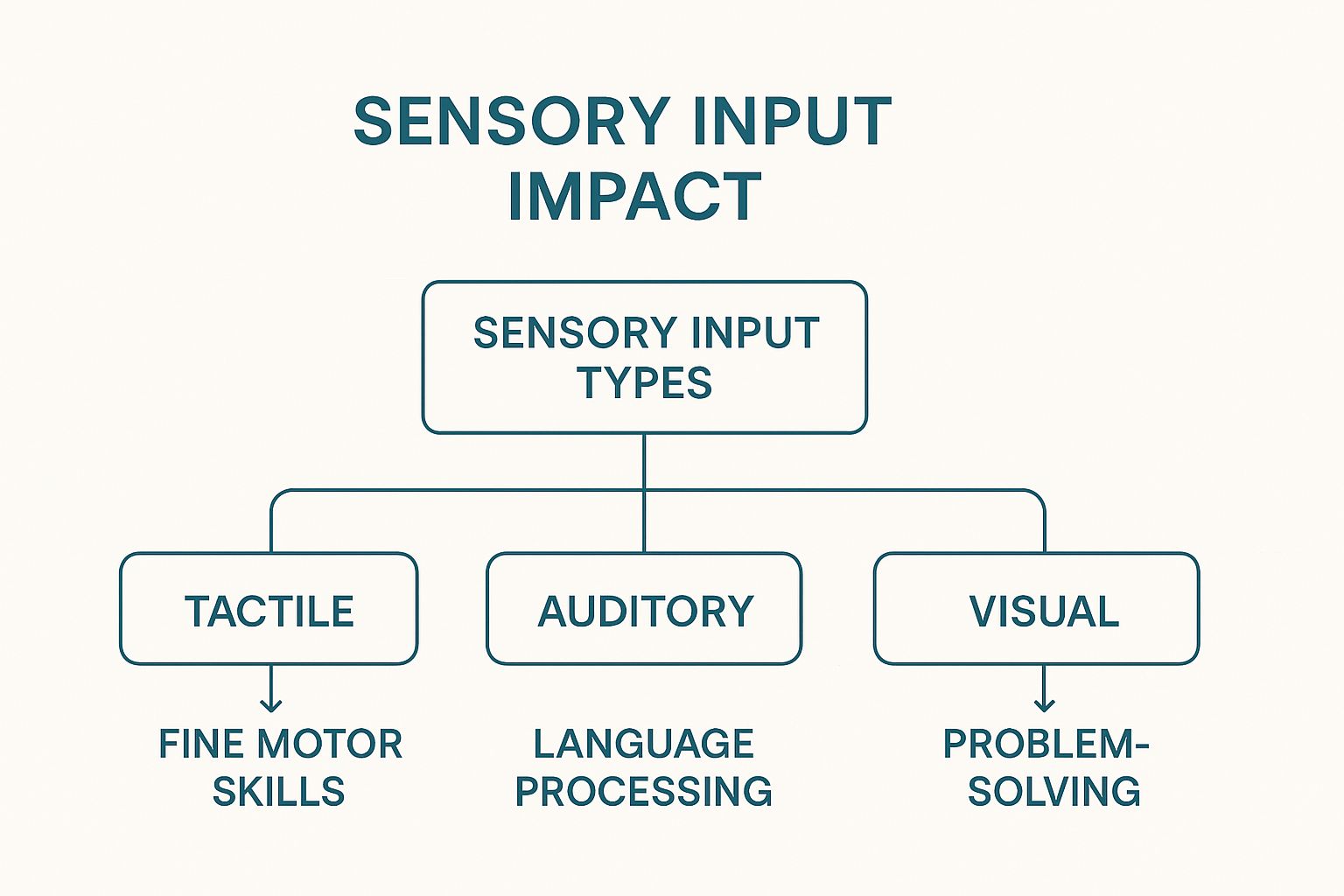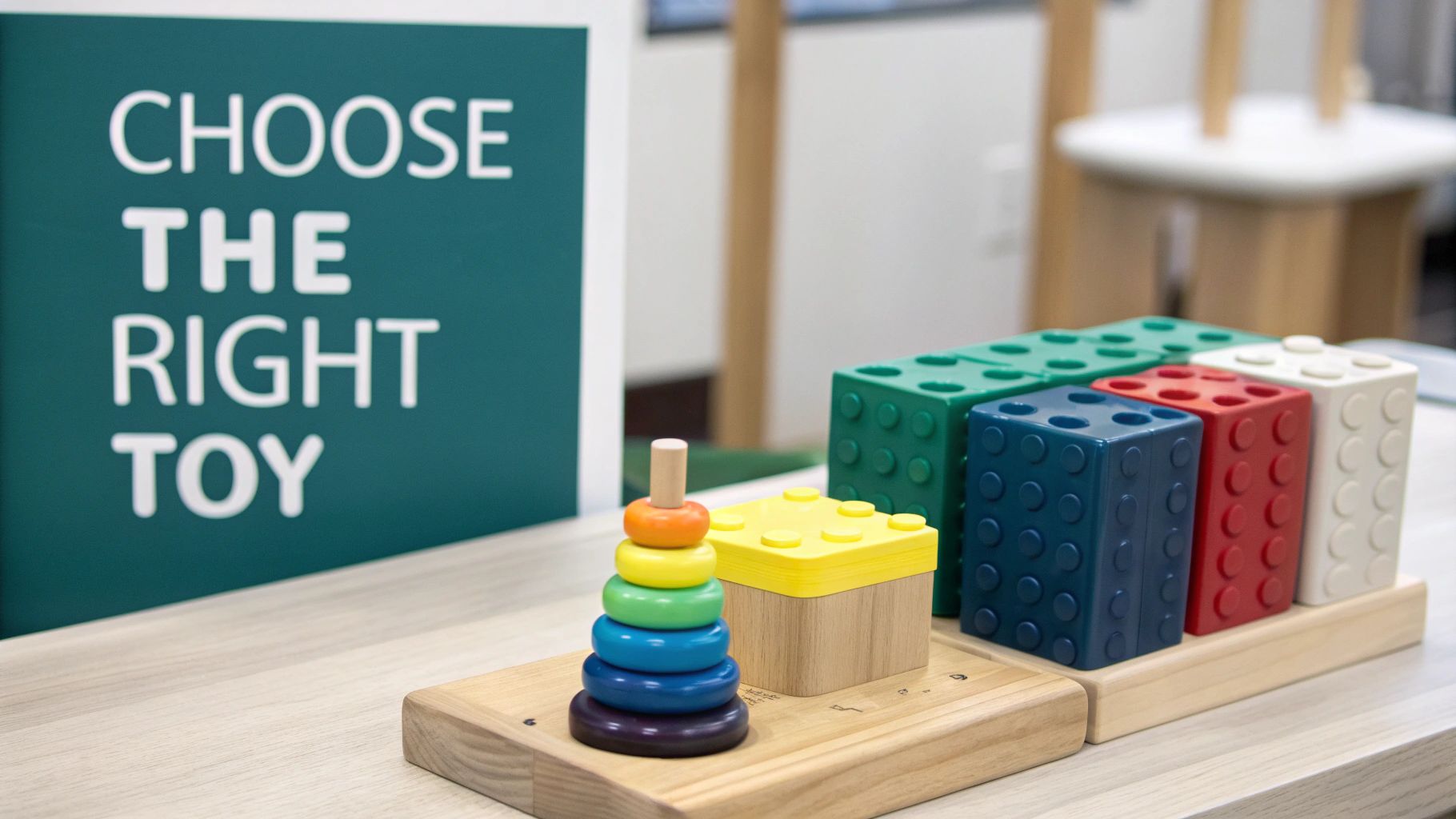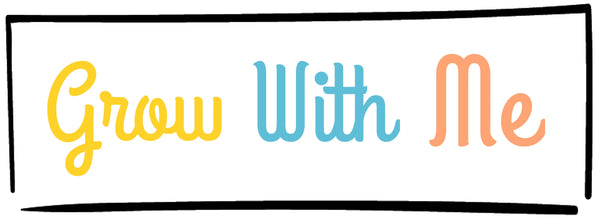
Best Sensory Toys for 2 Year Olds
Share
When we talk about sensory toys for 2-year-olds, we're not just talking about any old plaything. These are thoughtfully designed tools that get a toddler’s senses firing, encouraging them to explore and learn about the world around them. They are fundamental for building crucial brain connections through touch, sight, sound, and movement during one of the most explosive periods of their development.
Why Sensory Toys Are a Game Changer for Toddlers

Have you ever watched a two-year-old completely captivated by the feel of a soft blanket or the crinkly sound of a sweet wrapper? That’s sensory learning in action. At this age, a toddler’s brain is like a buzzing construction site, rapidly building the neural pathways that will form the foundation for everything they learn later in life.
Sensory play is the essential building material for this incredible construction project. When a child gets their hands on a sensory toy, they're doing so much more than just keeping busy. They’re running their own little experiments, figuring out how their world works piece by piece.
Building Brains Through Play
Think of a sensory toy as a conversation starter for your toddler's brain. Every new texture they feel, every sound they hear, and every colour they see gives them a fresh piece of information to help them grasp more complex ideas. This hands-on exploration is absolutely vital for developing a whole range of skills:
- Cognitive Skills: Pressing a button to hear a sound teaches the basics of cause and effect. Hiding a ball under a cup and finding it again reinforces object permanence—the amazing realisation that things still exist even when they’re out of sight.
- Fine Motor Skills: Squishing playdough, stacking textured blocks, or picking up small pegs all work to strengthen those tiny muscles in their hands and fingers. This is the groundwork for future skills like holding a crayon or using a fork.
- Language Development: As they explore, you can introduce a whole new world of words. Describing things as "squishy," "bumpy," or "smooth" links physical feelings to vocabulary, which is a huge boost for their communication skills.
- Emotional Regulation: Some sensory experiences can be incredibly calming. Think of running fingers through sand or listening to the gentle sound of a rainmaker. These activities can help toddlers learn to soothe themselves when they feel a bit overwhelmed.
Sensory play isn't just about having fun; it’s a direct line to your child's developing brain. It provides the essential input needed to forge strong neural connections that support problem-solving, creativity, and emotional well-being for years to come.
The Growing Importance of Developmental Toys
This focus on purposeful play is something parents are embracing all across the UK. The market for baby toys, a sector that includes sensory toys, is a rapidly growing area valued at around USD 821.5 million in 2024. Projections show it could nearly double by 2035, a trend driven by parents who are more aware than ever of the benefits of early developmental support.
If you’re interested, you can read the full research about the UK baby toys market to see how these trends are shaping what's on the shelves. It really highlights a clear shift towards choosing toys that do more than just entertain—they actively contribute to a child’s growth.
The Science Behind a Happier, More Engaged Toddler
If you want to understand the magic of sensory play, it helps to think of sensory input as high-quality 'brain food' for your rapidly developing two-year-old. Every new texture, sound, and sight is like a nutrient, building stronger, faster connections in their brain. These connections are the very foundation for all future learning.
This isn't just an abstract idea; it's happening in real-time. When your toddler squishes playdough between their fingers, they aren't just making a mess. They're actually strengthening the tiny hand muscles needed to eventually hold a pencil or use a fork. It’s a direct link between a tactile experience and a crucial physical skill.
In the same way, a simple musical toy does so much more than make noise. It helps a toddler's brain practise auditory processing—the ability to tell the difference between sounds, tones, and rhythms. This is fundamental for language development, helping them tune into the subtle differences in spoken words.
Building Skills Through Senses
Sensory play is a full-body experience that supports every part of your child's development, from cognitive leaps to emotional balance. By engaging their senses, these toys help toddlers make sense of the world in a way that feels natural and exciting.
The following infographic shows how different types of sensory input directly feed into key developmental areas.

As you can see, each sense offers a unique pathway for growth, turning simple playtime moments into powerful learning opportunities.
Beyond Motor Skills and Language
The benefits reach far beyond just physical and language milestones. Sensory play is also a fantastic tool for emotional and social growth.
-
Problem-Solving: Figuring out how to fit a shaped block into the right hole is a mini cognitive puzzle. It’s solved through visual and tactile feedback, building resilience and critical thinking through simple trial and error.
-
Emotional Regulation: Certain sensory activities have a wonderfully calming effect. Think about the repetitive motion of scooping and pouring rice in a sensory bin—it can help an overstimulated toddler self-soothe and find their focus again.
-
Body Awareness: Toys that encourage climbing, balancing, or spinning help develop their proprioceptive and vestibular senses. These are responsible for body awareness and knowing where they are in space, leading to better coordination and confidence in their movements.
Sensory toys are not just about keeping a toddler busy. They are carefully designed tools that provide the precise input a child's brain needs to organise information, regulate emotions, and master new skills.
Ultimately, these toys help create a more engaged and content toddler because they meet a fundamental developmental need. For a deeper look, explore our comprehensive guide on developmental toys for toddlers and discover how to support each stage of their amazing journey.
Finding the Right Sensory Toy for Your Child

Walking into a toy shop can feel a bit overwhelming, can’t it? Every box seems to promise it’s the next best thing for your toddler's development. But here’s the secret: you don’t need to find one single "perfect" toy.
The real key is to understand the different types of sensory play and match them to your child’s personality and what they’re curious about right now. By breaking down sensory toys for 2 year olds into a few main categories, you can pick things that will genuinely fascinate them and support their growth.
Let's dive into the main types you'll find, and what makes each one so valuable.
Touch and Feel Tactile Toys
These are the toys that are all about getting hands-on. Think different textures, interesting shapes, and squishy, satisfying materials. This kind of hands-on exploration is absolutely fundamental for a two-year-old, helping them make sense of their world while building up those crucial fine motor skills.
Every time they squish, poke, pull, and prod, they're strengthening the tiny muscles in their hands and fingers. It’s no surprise that tactile toys are a firm favourite among parents and therapists alike. They currently hold a 34% market share in the sensory toy space, and with around 67% of parents opting for sensory tools to support hands-on learning, it’s clear they fill a real need. For a deeper dive into these market trends, you can check out this detailed report on sensory toys.
Some classic examples of tactile toys include:
- Playdough or modelling clay: Perfect for endless squishing, rolling, and creating.
- Sensory bins: Fill a tub with dry pasta, sand, or even water for fantastic scooping and pouring fun.
- Textured balls: Look for ones with different bumps, ridges, and surfaces for little hands to explore.
- Fidget toys: Anything soft, squishy, or bumpy can provide great tactile feedback.
Engaging Sight and Sound Toys
Toys that focus on sight and sound are designed to grab a toddler's attention and help their brain get better at processing what they see and hear. The best ones use bright colours, gentle lights, or calming sounds to create an experience that’s engaging without being overwhelming.
Visual toys, like colourful stacking rings, help them focus and start to recognise patterns. Auditory toys, from simple shakers to toy xylophones, are brilliant for developing listening skills and teaching cause and effect. They quickly learn: "when I shake this, it makes a sound!"
A brilliant home-made option is a sensory bottle. You can easily make your own, and we've got a great guide to show you how. Take a look at our instructions for creating DIY sensory bottles for a simple and mesmerising visual toy.
Body Awareness Proprioceptive and Vestibular Toys
These categories might sound a bit technical, but the ideas behind them are simple: they’re all about movement and body awareness. Proprioceptive toys use deep pressure or resistance to help a child understand where their arms and legs are without having to look. Vestibular toys, on the other hand, are all about balance and movement, stimulating the inner ear.
These toys are essential for developing coordination, balance, and physical confidence. They help your toddler feel more grounded and secure as they learn to navigate the world.
Great examples for this age group are:
- Soft play equipment: For safe climbing, tumbling, and exploring.
- Balance boards or beams: A fun way to practise stability.
- Small trampolines: Great for controlled, joyful jumping.
- Weighted lap pads: These can have a wonderfully calming and grounding effect.
To help you see how it all fits together, here’s a quick breakdown of the different toy categories and what they offer your two-year-old.
Sensory Toy Categories and Their Benefits for a 2 Year Old
| Toy Category | Primary Sense Stimulated | Key Developmental Skills |
|---|---|---|
| Tactile Toys | Touch (Tactile) | Fine motor skills, texture discrimination, cause and effect |
| Visual Toys | Sight (Visual) | Focus, pattern recognition, visual tracking |
| Auditory Toys | Hearing (Auditory) | Listening skills, rhythm, sound differentiation |
| Proprioceptive Toys | Body Awareness | Coordination, self-regulation, motor planning |
| Vestibular Toys | Balance & Movement | Balance, spatial awareness, physical confidence |
By picking a few things from these different areas, you can easily build a small but incredibly effective collection of sensory toys for your 2 year old that covers all their developmental bases.
A Parent's Guide to Toy Safety and Quality
When you're picking out sensory toys for a two-year-old, safety isn't just a box to tick—it's everything. At this age, toddlers are wired to explore the world with their hands and mouths, which means every toy needs to be completely secure, tough enough for enthusiastic play, and made from materials you can trust.
It's easy to get swayed by clever marketing, but learning to spot the real signs of a safe, high-quality toy will give you peace of mind. Let’s walk through exactly what you need to look for.
Your Essential Safety Checklist
Before any toy makes it into your shopping basket, it’s worth giving it a quick once-over. You’re looking for any potential risks and checking if it can stand up to the joyful chaos of toddler play. In the UK, always look for the CE mark or the newer UKCA mark on the packaging. This is your assurance that the toy meets strict health and safety standards.
Here’s a practical checklist to keep in mind:
- Check for Small Parts: Are there any bits that could snap off? A good rule of thumb is the toilet paper tube test. If a piece is small enough to fit inside the tube, it’s a choking hazard for a child under three.
- Inspect the Materials: The toy should be made from non-toxic, BPA-free, and phthalate-free materials. Check for sturdy construction—no sharp edges, splinters on wooden toys, or flimsy seams that could let stuffing escape.
- Durability is Key: Give the toy a gentle tug and a squeeze. Does it feel like it might break under a bit of pressure? A well-made toy feels solid and ready for action.
Spotting a Genuinely Effective Toy
Once you're confident a toy is safe, the next question is about its play value. A truly great sensory toy does more than just keep a child busy; it sparks their curiosity and can be used in all sorts of different ways. This is what separates a five-minute wonder from a toy that becomes a beloved favourite for months, or even years.
The best sensory toys are often the simplest. They are open-ended, meaning they don't have a single, fixed purpose. This empowers your child to lead the play, fostering creativity, problem-solving, and imagination.
So, how can you spot one in the wild? Look for toys that encourage open-ended play. Think about a set of simple wooden blocks. They can be a towering skyscraper, a fence for toy animals, or a winding road for a little car. They can be stacked, sorted, and knocked over, offering a new adventure every single time.
On the other hand, a toy that only does one thing when a button is pressed has limited creative potential. While these can be fun in small doses, it’s all about balance. Try to prioritise toys that get a child’s mind working without overwhelming them with flashing lights and loud sounds. A toy that invites exploration, rather than dictating it, will always offer far richer developmental benefits.
How to Create a Sensory-Rich Play Environment at Home

Even the most brilliant sensory toys for 2-year-olds come alive when they’re part of an engaging, playful environment. You don't need a perfectly kitted-out playroom or loads of expensive gear to fire up your toddler’s curiosity. The real magic happens when you start weaving sensory experiences into your everyday life, turning ordinary moments into brilliant little adventures.
Transforming your home into a sensory wonderland is much simpler than it sounds. It’s all about being a bit more intentional with what you already have and, yes, embracing a little bit of creative mess. A slight shift in perspective can turn a kitchen cupboard or a patch of the garden into a whole new world to explore.
Simple Setups with Big Impact
You can create some truly fantastic sensory activities with things you’ve probably got lying around the house. These low-cost, high-impact ideas are perfect for introducing your two-year-old to new textures and ideas in a place they already feel safe and comfortable. The aim is to offer tools that encourage open-ended play, where your child is the director of their own fun.
Here are a few easy ideas to get you started:
- Make a Sensory Bin: Grab a shallow storage tub and fill it with taste-safe materials like dry pasta, oats, or rice. Add some scoops, cups, and small toys to encourage pouring, digging, and hiding. This is a classic for a reason—it’s amazing for fine motor skills.
- Set Up a Water Station: On a warm day, a simple washing-up bowl in the garden can provide hours of entertainment. Throw in some sponges, funnels, and plastic toys to explore concepts like floating, sinking, and splashing.
- Build a Cosy Den: Drape a blanket over a couple of chairs and fill the space with cushions and soft toys. This creates a calming, enclosed space where your toddler can retreat, relax, and feel secure.
If you’re looking for more inspiration, you can find a whole host of brilliant and simple sensory play ideas for toddlers to fill your day.
Your Role in Their Play
While fantastic toys and activities set the stage, it’s your involvement that truly brings the learning to life. You are your child’s most important playmate. How you engage with them can deepen their understanding and build their confidence in amazing ways. You don’t need to lead the play; just being there and describing what's happening makes a world of difference.
Your words build their world. By narrating their sensory experiences—"The water feels so cool!" or "That pasta is making a rattling sound"—you connect physical feelings to language. This creates a rich foundation for their vocabulary and communication skills.
This is often called ‘scaffolding’, and it’s all about guiding their learning without taking over. Think of it as a partnership where you provide the support and encouragement they need to make their own incredible discoveries.
Guiding Play to Maximise Learning
Guiding your toddler’s play is less about teaching and more about wondering alongside them. By using descriptive language and asking open-ended questions, you can spark their thinking and help them forge new connections in their busy little brains.
Try using phrases like:
- "Wow, that playdough feels so squishy in your hands!"
- "Listen to the sound the blocks make when they tumble down."
- "I wonder what will happen if we pour the water into this cup?"
This approach turns playtime into a shared adventure. It shows your child you’re present and genuinely interested in their world, which strengthens your bond and helps turn your home into the vibrant, supportive learning environment they deserve.
A Few Common Questions About Sensory Toys
Even after getting to grips with the basics of sensory play, it’s natural for parents to have a few questions pop up. You want to do the best for your toddler, and that often means digging a little deeper. Let’s clear up some of the most common queries about sensory toys for two-year-olds.
How Many Sensory Toys Does My Toddler Actually Need?
It's so easy to fall into the "more is more" trap, but when it comes to sensory toys, the opposite is usually true. Quality always trumps quantity. A huge pile of toys can overwhelm a toddler, making it tough for them to focus on any one thing and really get lost in play.
Instead of aiming for a specific number, think about creating a small, thoughtful collection. You just need a few open-ended toys that cover different sensory experiences—maybe one or two things for touch, sight, sound, and movement. A great trick is to use a toy rotation system. Just pack some toys away for a few weeks and bring them out later. It keeps their play space feeling fresh and exciting without the clutter.
A handful of versatile, well-chosen toys that spark the imagination will offer far more developmental value than a room full of flashy, single-purpose gadgets. Less really is more.
The UK toys market is huge—valued at around USD 3.91 billion in 2024—so the sheer number of options can be dizzying. With online shopping making it easier to find information, parents can make really thoughtful choices. You can discover more insights about the UK toy market to see how the trend is shifting towards more purposeful play.
Aren't These Toys Just for Children with Developmental Delays?
This is a really common misconception, but the answer is a firm no. While sensory toys are fantastic tools in therapy for children with sensory processing challenges or developmental delays, their benefits are for everyone. Every single toddler learns through their senses.
Sensory play is a core part of how all children develop. It’s what helps them build crucial nerve connections in the brain, fine-tune their motor skills, and make sense of the world around them. For a typical two-year-old, these toys are simply brilliant, engaging tools for everyday learning and discovery.
What Actually Makes a Toy "Sensory"?
So, what’s the difference between a "sensory" toy and any old toy? It all comes down to intentional design. A sensory toy is purposefully made to stimulate one or more of the senses in a targeted way.
Think about it like this:
- A regular toy car is great for zipping around and imaginative games.
- A sensory toy car, on the other hand, might have textured wheels, a soft-touch body, or make a gentle clicking sound as it moves.
It’s this deliberate focus on providing specific sensory feedback that makes these toys so powerful. They're designed from the ground up to invite a child to explore with their hands, eyes, and ears.
How Do I Clean These Toys Safely?
Knowing that toddlers love to explore with their mouths, keeping their toys clean is a top priority. The first step is always to check the manufacturer’s instructions.
For most toys, a simple wash with mild soap and water or a wipe-down with a 50/50 mix of white vinegar and water is all you need. It’s best to avoid harsh chemical cleaners. For things like wooden toys, a quick wipe with a damp cloth is better than soaking to avoid damaging the wood. A little bit of regular, gentle cleaning keeps your child’s play environment healthy and safe.
Ready to give your toddler the gift of meaningful play? At Grow With Me, we curate age-appropriate play kits filled with high-quality sensory and wooden toys that support your child’s development at every stage. Explore our subscription boxes and find the perfect tools to spark curiosity and learning. https://shop.growwithmesubscriptionbox.co.uk
